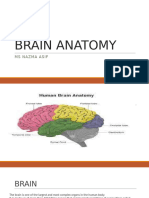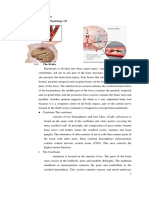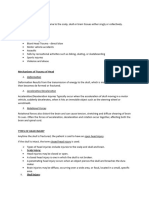0 ratings0% found this document useful (0 votes)
35 viewsPicture of The Brain: Prev Next
Picture of The Brain: Prev Next
Uploaded by
MarvinEboraThe brain is the largest and most complex organ in the human body, composed of over 100 billion nerves connected by trillions of synapses. It is made up of specialized areas including the cortex for thinking and movement, brain stem for basic functions, basal ganglia for coordinating messages, and cerebellum for coordination and balance. The brain is also divided into frontal, parietal, temporal, and occipital lobes responsible for various functions. The meninges surround and protect the brain within the skull.
Copyright:
© All Rights Reserved
Available Formats
Download as DOCX, PDF, TXT or read online from Scribd
Picture of The Brain: Prev Next
Picture of The Brain: Prev Next
Uploaded by
MarvinEbora0 ratings0% found this document useful (0 votes)
35 views4 pagesThe brain is the largest and most complex organ in the human body, composed of over 100 billion nerves connected by trillions of synapses. It is made up of specialized areas including the cortex for thinking and movement, brain stem for basic functions, basal ganglia for coordinating messages, and cerebellum for coordination and balance. The brain is also divided into frontal, parietal, temporal, and occipital lobes responsible for various functions. The meninges surround and protect the brain within the skull.
Original Title
brain101
Copyright
© © All Rights Reserved
Available Formats
DOCX, PDF, TXT or read online from Scribd
Share this document
Did you find this document useful?
Is this content inappropriate?
The brain is the largest and most complex organ in the human body, composed of over 100 billion nerves connected by trillions of synapses. It is made up of specialized areas including the cortex for thinking and movement, brain stem for basic functions, basal ganglia for coordinating messages, and cerebellum for coordination and balance. The brain is also divided into frontal, parietal, temporal, and occipital lobes responsible for various functions. The meninges surround and protect the brain within the skull.
Copyright:
© All Rights Reserved
Available Formats
Download as DOCX, PDF, TXT or read online from Scribd
Download as docx, pdf, or txt
0 ratings0% found this document useful (0 votes)
35 views4 pagesPicture of The Brain: Prev Next
Picture of The Brain: Prev Next
Uploaded by
MarvinEboraThe brain is the largest and most complex organ in the human body, composed of over 100 billion nerves connected by trillions of synapses. It is made up of specialized areas including the cortex for thinking and movement, brain stem for basic functions, basal ganglia for coordinating messages, and cerebellum for coordination and balance. The brain is also divided into frontal, parietal, temporal, and occipital lobes responsible for various functions. The meninges surround and protect the brain within the skull.
Copyright:
© All Rights Reserved
Available Formats
Download as DOCX, PDF, TXT or read online from Scribd
Download as docx, pdf, or txt
You are on page 1of 4
Picture of the Brain
Human Anatomy
By Matthew Hoffman, MD
Medically Reviewed by Carol DerSarkissian, MD on June 23, 2021
© 2014
WebMD, LLC. All rights reserved.
PREV
NEXT
The brain is one of the largest and most complex organs in the human
body.
It is made up of more than 100 billion nerves that communicate in trillions
of connections called synapses.
The brain is made up of many specialized areas that work together:
• The cortex is the outermost layer of brain cells. Thinking and voluntary
movements begin in the cortex.
• The brain stem is between the spinal cord and the rest of the brain. Basic
functions like breathing and sleep are controlled here.
• The basal ganglia are a cluster of structures in the center of the brain. The
basal ganglia coordinate messages between multiple other brain areas.
• The cerebellum is at the base and the back of the brain. The cerebellum is
responsible for coordination and balance.
The brain is also divided into several lobes:
• The frontal lobes are responsible for problem solving and judgment and
motor function.
• The parietal lobes manage sensation, handwriting, and body position.
• The temporal lobes are involved with memory and hearing.
• The occipital lobes contain the brain's visual processing system.
The brain is surrounded by a layer of tissue called the meninges. The skull
(cranium) helps protect the brain from injury.
SUGGESTED
Brain Conditions
Headache: There are many types of headaches; some can be serious
but most are not and are generally treated with analgesics/painkillers.
Stroke (brain infarction): Blood flow and oxygen are suddenly
interrupted to an area of brain tissue, which then dies. A blood clot,
or bleeding in the brain, are the cause of most strokes.
Brain aneurysm: An artery in the brain develops a weak area that
swells, balloon-like. A brain aneurysm rupture can causes a stroke.
Subdural hematoma: Bleeding within or under the dura, the lining
inside of the skull. A subdural hematoma may exert pressure on the
brain, causing neurological problems.
Epidural hematoma: Bleeding between the tough tissue (dura) lining
the inside of the skull and the skull itself, usually shortly after a head
injury. Initial mild symptoms can progress rapidly to
unconsciousness and death, if untreated.
Intracerebral hemorrhage: Any bleeding inside the brain.
Concussion: A brain injury that causes a temporary disturbance in
brain function. Traumatic head injuries cause most concussions.
Cerebral edema: Swelling of the brain tissue in response to injury or
electrolyte imbalances.
Brain tumor: Any abnormal tissue growth inside the brain. Whether
malignant (cancer) or benign, brain tumors usually cause problems
by the pressure they exert on the normal brain.
Glioblastoma: An aggressive, malignant brain tumor (cancer). Brain
glioblastomas progress rapidly and are very difficult to cure.
Hydrocephalus: An abnormally increased amount of cerebrospinal
(brain) fluid inside the skull. Usually this is because the fluid is not
circulating properly.
Normal pressure hydrocephalus: A form of hydrocephalus that often
causes problems walking, along with dementia and urinary
incontinence. Pressures inside the brain remain normal, despite the
increased fluid.
Meningitis: Inflammation of the lining around the brain or spinal
cord, usually from infection. Stiff neck, neck pain, headache, fever,
and sleepiness are common symptoms.
Encephalitis: Inflammation of the brain tissue, usually from infection
with a virus. Fever, headache, and confusion are common symptoms.
Traumatic brain injury: Permanent brain damage from a traumatic
head injury. Obvious mental impairment, or more subtle personality
and mood changes can occur.
Parkinson's disease: Nerves in a central area of the brain degenerate
slowly, causing problems with movement and coordination. A
tremor of the hands is a common early sign.
Huntington's disease: An inherited nerve disorder that affects the
brain. Dementia and difficulty controlling movements (chorea) are its
symptoms.
Epilepsy: The tendency to have seizures. Head injuries and strokes
may cause epilepsy, but usually no cause is identified.
Dementia: A decline in cognitive function resulting from death or
malfunction of nerve cells in the brain. Conditions in which nerves in
the brain degenerate, as well as alcohol abuse and strokes, can cause
dementia.
Alzheimer’s disease: For unclear reasons, nerves in certain brain
areas degenerate, causing progressive dementia. Alzheimer’s disease
is the most common form of dementia.
Brain abscess: A pocket of infection in the brain, usually by bacteria.
Antibiotics and surgical drainage of the area are often necessary.
You might also like
- HandbookOfInternalMedicineHA PDFDocument430 pagesHandbookOfInternalMedicineHA PDFian3yeung-2100% (1)
- ELS 102 Theories of Language Module 12-15Document13 pagesELS 102 Theories of Language Module 12-15LovelyLoey ParkNo ratings yet
- Rain Conditions: Headache StrokeDocument2 pagesRain Conditions: Headache StrokeSameer KshitizNo ratings yet
- DEMENTIA-WPS OfficeDocument14 pagesDEMENTIA-WPS OfficeDauda Muize AdewaleNo ratings yet
- BRAIN ANATOMY Part 2 08102024 113227amDocument14 pagesBRAIN ANATOMY Part 2 08102024 113227amSultan AwanNo ratings yet
- Neck Pain Headache: Brain Diseases: InfectionsDocument2 pagesNeck Pain Headache: Brain Diseases: Infectionsv@r0_5No ratings yet
- Disease of Nervous System Lect 2Document62 pagesDisease of Nervous System Lect 2Monirul IslamNo ratings yet
- Chapt 12 AU2024Document83 pagesChapt 12 AU2024mayadesilva2014No ratings yet
- TBI QuizletDocument4 pagesTBI QuizletLoraine CometaNo ratings yet
- Nervous SystemDocument9 pagesNervous SystemAlbert SaipNo ratings yet
- Cerebral EdemaDocument62 pagesCerebral EdemaALL IN OÑENo ratings yet
- Nervous System 2Document36 pagesNervous System 2Aysun AlizadehNo ratings yet
- Nervous SystemDocument5 pagesNervous SystemLola MipezNo ratings yet
- Nervous System DiseasesDocument16 pagesNervous System DiseasesShahzad ShameemNo ratings yet
- Neurological System DisordersDocument41 pagesNeurological System DisordersJoanna Ephraim CruzNo ratings yet
- Powerpoint Presentation: Vini V.T REG NO:181/14376022 Natural Science New B.Ed College NellimooduDocument13 pagesPowerpoint Presentation: Vini V.T REG NO:181/14376022 Natural Science New B.Ed College NellimooduviniNo ratings yet
- Nervous System PathologyDocument57 pagesNervous System Pathologypatriciasuscking100% (1)
- 2.4 Neurological ProblemsDocument22 pages2.4 Neurological Problemsturtlesrule136No ratings yet
- Neurological System DisordersDocument59 pagesNeurological System DisordersJoanna Ephraim CruzNo ratings yet
- Nevous System Disorder by Mehed AbduDocument261 pagesNevous System Disorder by Mehed Abdubekelesoresa2No ratings yet
- Seminar 5 MG IIDocument6 pagesSeminar 5 MG IIrussianangelNo ratings yet
- IV-14.1 Handouts - Module 11 Brain Injury-OverheadsDocument42 pagesIV-14.1 Handouts - Module 11 Brain Injury-Overheadsechika14No ratings yet
- BioPsychology: Brain DamageDocument45 pagesBioPsychology: Brain DamageajieNo ratings yet
- Head InjuryDocument48 pagesHead InjuryAdult LearnerNo ratings yet
- The BrainDocument14 pagesThe Brainchristine alfaroNo ratings yet
- 4 - Perception & Coordination Alterations RVDocument391 pages4 - Perception & Coordination Alterations RVgeng gengNo ratings yet
- 3.03 Understand Structures, Functions and Disorders of The Nervous SystemDocument38 pages3.03 Understand Structures, Functions and Disorders of The Nervous SystemLoriwinchesterNo ratings yet
- Central Nervous SystemDocument41 pagesCentral Nervous SystemVicencio, JhezelNo ratings yet
- Pathologies of Central Nervous SystemDocument51 pagesPathologies of Central Nervous SystemSajjad AliNo ratings yet
- Head Injury... Jackie 1Document54 pagesHead Injury... Jackie 1Fatius KagenziNo ratings yet
- Translated Copy of Concept of DiseasesDocument14 pagesTranslated Copy of Concept of DiseasesFitria NorkhalidaNo ratings yet
- Ingles - 1° AñoDocument43 pagesIngles - 1° AñoRox Sof100% (1)
- Anatomi Nervous System (Stroke) New (Autosaved)Document44 pagesAnatomi Nervous System (Stroke) New (Autosaved)Muhammad Syauqi bin AzmiNo ratings yet
- Human Brain (Mini Project) FNLDocument35 pagesHuman Brain (Mini Project) FNLSayyeda SumaiyahNo ratings yet
- Head Injurie, .... by MakdaDocument126 pagesHead Injurie, .... by MakdayewollolijfikreNo ratings yet
- Intracranial Regulation: Scope of ICRDocument7 pagesIntracranial Regulation: Scope of ICRTamanda MushoreNo ratings yet
- CCN Lecture Altered PerceptionDocument4 pagesCCN Lecture Altered PerceptionPatricia VasquezNo ratings yet
- How The Brain Works: Understanding Brain Function, Thought and PersonalityFrom EverandHow The Brain Works: Understanding Brain Function, Thought and PersonalityNo ratings yet
- Brain 2Document2 pagesBrain 2bambangNo ratings yet
- Anaphy Activity 8Document6 pagesAnaphy Activity 8PENNY KEDAWENNo ratings yet
- Head InjuryDocument10 pagesHead InjuryMelia SariNo ratings yet
- BrainDocument15 pagesBraindiagrodaisy3No ratings yet
- Neurocognitive and Other Disorders Due To Another Medical ConditionDocument26 pagesNeurocognitive and Other Disorders Due To Another Medical ConditionMrinaliniam PandeyamNo ratings yet
- 6 Nervous SystemDocument21 pages6 Nervous SystempandyaalphaNo ratings yet
- Medical Terminology 13Document37 pagesMedical Terminology 13Tuaha MasoodNo ratings yet
- Case Tudy PaDocument13 pagesCase Tudy PaJestoni GutierrezNo ratings yet
- KP 8 (Pak Zahid) Head and Neck InjuryDocument57 pagesKP 8 (Pak Zahid) Head and Neck InjurySony NugrohoNo ratings yet
- A3 PathophysiologyDocument7 pagesA3 PathophysiologysonpengNo ratings yet
- Brain Growth and DevelopmentDocument5 pagesBrain Growth and Developmentmortadhap900No ratings yet
- PDF Nervous SystemDocument12 pagesPDF Nervous Systemfardinmfkhan182002No ratings yet
- Nervous system p2Document3 pagesNervous system p2friendlyrodentsNo ratings yet
- Lesson 4 Neurological ConditionsDocument18 pagesLesson 4 Neurological ConditionsElvis MasigaNo ratings yet
- Disorders of The Nervous Tissues and The BrainDocument3 pagesDisorders of The Nervous Tissues and The BrainCharls DeimoyNo ratings yet
- Brain Conditions: Parkinson's DiseaseDocument1 pageBrain Conditions: Parkinson's DiseaseSameer KshitizNo ratings yet
- Unit 1 Week 10 GlossaryDocument1 pageUnit 1 Week 10 Glossaryscarlettcrawley2007No ratings yet
- Nervous System DisordersDocument19 pagesNervous System Disordersمحمود محمدNo ratings yet
- Diseases and Disorders of The Nervous System.Document22 pagesDiseases and Disorders of The Nervous System.Patricia NicoleNo ratings yet
- Nervous SystemDocument49 pagesNervous SystemVinDiesel Balag-eyNo ratings yet
- Head InjuryDocument6 pagesHead Injurychuramarak23No ratings yet
- Brain TumorDocument26 pagesBrain TumorVikas SinghNo ratings yet
- Life 101Document3 pagesLife 101MarvinEboraNo ratings yet
- Chap 10 2 HW 10Document2 pagesChap 10 2 HW 10MarvinEboraNo ratings yet
- Essential Meaning of LifeDocument3 pagesEssential Meaning of LifeMarvinEboraNo ratings yet
- 10 6 PDFDocument10 pages10 6 PDFAbdullahNo ratings yet
- The CatDocument5 pagesThe CatMarvinEboraNo ratings yet
- Flanged Bolt Couplings - Mathalino: Skip To Main Content Accessibility FeedbackDocument5 pagesFlanged Bolt Couplings - Mathalino: Skip To Main Content Accessibility FeedbackMarvinEboraNo ratings yet
- Calcitriol, Calcium Carbonate and Zinc Capsules Calzem CompositionDocument5 pagesCalcitriol, Calcium Carbonate and Zinc Capsules Calzem CompositionAnjali MongaNo ratings yet
- Chamomilla: Materia MedicaDocument29 pagesChamomilla: Materia MedicaA.H. Lammert Holdijk100% (1)
- Department of Education: Plan Alusugan Sa Deped Progress ReportDocument16 pagesDepartment of Education: Plan Alusugan Sa Deped Progress Reportjunapoblacio100% (2)
- Task 1 - PDD - Completed Task Model AnswerssDocument5 pagesTask 1 - PDD - Completed Task Model AnswerssGis ThaNo ratings yet
- Microbiology - 18Document7 pagesMicrobiology - 18karmylle andradeNo ratings yet
- Drug Study (Chlordiazepoxide, Lorazepam)Document4 pagesDrug Study (Chlordiazepoxide, Lorazepam)Kuro Hanabusa100% (2)
- Related Literary RiviewDocument6 pagesRelated Literary RiviewShakira Louise BranzuelaNo ratings yet
- Indications For Weaning: Kilips Classification of Ami With Expected Hospital Mortality RateDocument8 pagesIndications For Weaning: Kilips Classification of Ami With Expected Hospital Mortality RateSerious LeoNo ratings yet
- CPG PSSTDDocument40 pagesCPG PSSTDotartil_niman100% (2)
- Physiotherapy Documentation..exampleDocument11 pagesPhysiotherapy Documentation..examplevingkadwiiniNo ratings yet
- ORAL MANIFESTATIONS OF SYSTEMIC DISEASES Part 1Document97 pagesORAL MANIFESTATIONS OF SYSTEMIC DISEASES Part 1Shreya singhNo ratings yet
- Case Study MHPTDocument10 pagesCase Study MHPTHalfIeyzNo ratings yet
- Haad Exam McqsDocument727 pagesHaad Exam McqsSadafRafiNadeemNo ratings yet
- Indiba Animal Health GuidelinesDocument21 pagesIndiba Animal Health Guidelinesallfit.davidNo ratings yet
- Asco Answers BreastDocument2 pagesAsco Answers BreastvikasNo ratings yet
- TUSHEEEEEEDocument1 pageTUSHEEEEEEKenii DungaNo ratings yet
- BRONCHIOLITISDocument8 pagesBRONCHIOLITISAGUS DE COLSANo ratings yet
- CASE STUDY #3 Urinary System (Urninary Tract Infection or UTI)Document5 pagesCASE STUDY #3 Urinary System (Urninary Tract Infection or UTI)Lerma PagcaliwanganNo ratings yet
- BURNDocument5 pagesBURNLara TechiesNo ratings yet
- Cerebral EdemaDocument21 pagesCerebral EdemasridharNo ratings yet
- TB Medication ArabicDocument6 pagesTB Medication ArabicanasskaicharNo ratings yet
- Fischer G. the Vulva. a Practical Handbook for Clinicians 3ed 2023Document177 pagesFischer G. the Vulva. a Practical Handbook for Clinicians 3ed 2023mrl.alex.wanderiNo ratings yet
- Nausea and Vomiting During PregnancyDocument8 pagesNausea and Vomiting During PregnancyRomadhona KhoiriNo ratings yet
- Summary - Hyaline Membrane DiseaseDocument1 pageSummary - Hyaline Membrane DiseaseJet BautistaNo ratings yet
- Neet PytDocument60 pagesNeet Pytathanki.familyNo ratings yet
- PrakritiDocument3 pagesPrakritiSaini VarunNo ratings yet
- KENDRIYA VIDYALAYA Biology Investigatory ProjectDocument28 pagesKENDRIYA VIDYALAYA Biology Investigatory Projectvishali GNo ratings yet
- Board Exam Compilation Book 3 SampleDocument9 pagesBoard Exam Compilation Book 3 Sampleebookwholeseller100% (1)
- Mupirocin Drug StudyDocument1 pageMupirocin Drug StudyArthur Christopher Corpuz0% (1)































































































